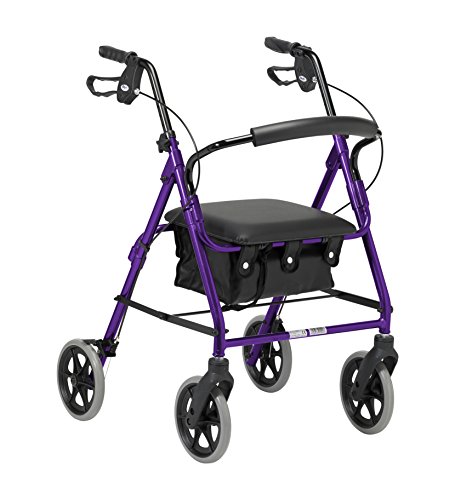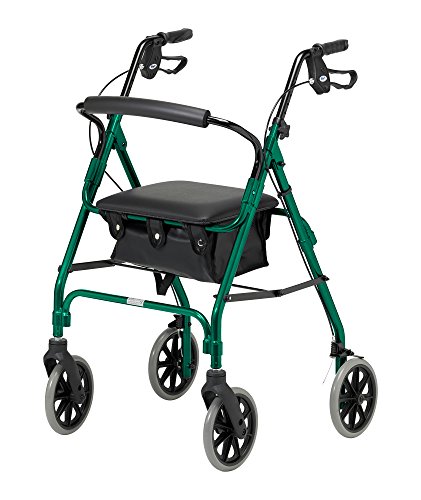See What Rollator Mobility Walker Tricks The Celebs Are Using
페이지 정보

본문
 rollator mobility walker (Check Out Chessdatabase)
rollator mobility walker (Check Out Chessdatabase)Rollators are a great choice for those with limited mobility and need stability while walking. They have big wheels and a space for a seat built into their frames.
 This model has cushioned handles that provide comfort and relieve hand pressure. It comes with height-adjustable handles as well as clever loop locks that stop the walker from moving when you are sitting or resting.
This model has cushioned handles that provide comfort and relieve hand pressure. It comes with height-adjustable handles as well as clever loop locks that stop the walker from moving when you are sitting or resting.Comfort
If someone has suffered an injury that affects their gait and balance or recovering from knee, hip, or other lower-limb surgeries, or injuries, a rollator mobility walker can aid. These walking aids provide stability and support, allowing users to walk more comfortably and remain active with their family and friends, as well as with the community.
They are available in a variety of styles including the traditional walker with wheels that appears less attractive than a walker with wheels. The handles of walker typically are placed at a level that is comfortable for the user, which makes them ideal for those who requires a stable support, but is able to move forward more easily than with a cane.
However, the wheels on a rollator make it more flexible than a regular walker, and easier to use. The wheels are positioned closer together, so it is easier to navigate and steer the device in tight spaces. they can also be rotated to increase the speed of going up or down steps. Many rollators come with an armchair and a crossbar that provide users with a place to sit down when they need to.
Handles for rollators are constructed of materials that differ in thickness and texture. Grips made of plastic can be taxing for anyone with arthritic hands So, look for soft and textured handles that are easy to hold. Also, take into consideration whether the model you pick includes loop-lock brakes, or lean-activated breaks to cater to different hand strength levels.
Stability
A great rollator must come with a comfortable and spacious seat that users can sit on when they want to take a break. It should be equipped with soft, ergonomic grips and brakes that are simple to operate. The grips should be cushioned and comfortable for people with wrist or hand problems. Some models come with a cushioned backrest for additional support. It is important to find the right walker with enough capacity for your weight and also one with adjustable handles to accommodate your height.
A walker with an locking mechanism is crucial for those who frequently travel or need to transport their walker into and out of vehicles. This will prevent the walker being opened accidentally during transport, preventing injury and other harm. Another feature to consider is whether the walker is removable and interchangeable parts which allows you to customize it to suit your needs.
In a recent research, researchers examined how task-performance strategy and device load affect the the stability of users of rollators. The study involved ten people who sells rollator walkers completed six tasks using an instrumented purple rollator walker. The team measured the total centre of pressure and the base of support which is known as system Stability Margin (SM). They discovered that SM decreases significantly from straight line walking to other activities. They also discovered that leaning on the device increases the centre of pressure within the base of support. This can increase or decrease stability. The authors conclude that the findings may be used to improve training for safe use of the rollator. They suggest that greater emphasis should be put on other activities that are not straight line walking and on specific strategies to perform each task that could aid or hinder stability.
Weight-bearing capacity
A rollator walker is capable of supporting up to 300 pounds or more, based on the model. Its sturdy frame and four wheels help people maintain their mobility and balance, particularly for those with medical conditions or ageing. Rollators are easier to maneuver than walkers with standard features that require users to lift their weight to move forward. This reduces hand fatigue.
The wheels on a rollator typically range in size from 6 to 10 inches in diameter, providing users with the ability to work indoors and outdoor use on a variety of surfaces. Some models come with a variety of height settings to accommodate different users. Others fold up to make it easy to transport and store. Some models have a seat that lets the user sit down while walking.
Many walkers include a variety accessories. For example, a walker tray or basket for holding personal things. Additional accessories include a wrist guard to shield hands from injuries and a walker bag to carry more belongings. Some walker frames are converted into wheelchairs if the mobility requirements of an individual change.
A bariatric rollerator is designed to accommodate larger people safely. It is constructed with a sturdy frame and a larger seat. It features a comfortable seat and adjustable handles, and locking hand brakes to ensure maximum security. The angled handlebars place the hands in a comfortable, neutral position. The strap for storage is convenient and allows it to be easily fitted to a trunk of a vehicle. Its sturdy 8" wheels are fitted with anti-tip technology that provides more stability and maneuverability and the cushioned seat offers an ideal place to rest while you travel.
Brakes
A tall rollator operates differently than the traditional walker. Instead of having all four legs touch the ground, a rollator features wheels that can be controlled by hand brakes located below or integrated into the handlebars. This design helps to make it easier for users to navigate tight spaces and make quick left or right turns. The brakes can become hard to operate or loose, which can pose a safety risk for people with weaker muscles and declining mobility.
Many manufacturers allow adding brakes that can be locked to increase safety and stability. This feature is particularly beneficial for those who have difficulty squeezing the brakes or applying pressure due to a weak grip or other health issues such as arthritis. While there are a few differences in how the locking brakes are adjusted walkers follow similar steps to ensure proper adjustment.
Before attempting to adjust the brakes of your lock it is recommended to study any maintenance guidelines included in your mobility aid for specific instructions. To begin with, locate the brake adjustment knob or screw, which is typically located near the handle grips, and tighten it by turning it clockwise. This step is important because if the adjuster has not been properly tightened it will not be possible to remove the brake cable from its slack. Once you have tightened the screw for adjustment of the brake, move on to the lower nut for the adjuster and tighten it with the same procedure. Once you've completed these adjustments, test your brakes by gently squeezing the levers. If they do not then it is most likely that the locking mechanism is damaged.
Accessories
A variety of accessories are available for rollator walkers, including baskets and cup holders. Some accessories are designed to carry things when walking, while others, such as the Mobility Phone Grip clip onto the vertical bars on a walker, or wheelchair, and expand to hold the phone. The grips can also be adjusted to the ideal height to hold your device. Many of these gadgets are designed to be light and easy to use, making them ideal for those with arthritis or other hand injuries.
Most manufacturers of walker and rollator provide a range of handle sizes, so you can choose the best one for your body type. It is also important to think about the capacity of a rollator's weight since this can affect how well it functions for you. Certain manufacturers offer models for bariatrics that can handle up to 500 pounds.
Another aspect to take into consideration when choosing a walker rollator is the type of brakes it has. Push down brakes function by placing downward pressure on the frame to stop forward motion. Loop brakes are similarly designed, however, they require simultaneous use of both hands and more physical strength to apply. Both brake types provide essential safety features, so it is crucial to select the one that is right for you.
If you're not sure which type of walker or rollator is the right one for you, it's suggested that you talk to a doctor, physical therapist, or occupational therapist. They can provide you with suggestions on features that are most useful for your particular situation and assist you find a model compatible with any equipment you have at home or stored.
- 이전글ADHD Titration UK Tools To Ease Your Daily Lifethe One ADHD Titration UK Trick Every Individual Should Learn 24.12.25
- 다음글Instant Check for Private Instagram Accounts 24.12.25
댓글목록
등록된 댓글이 없습니다.

